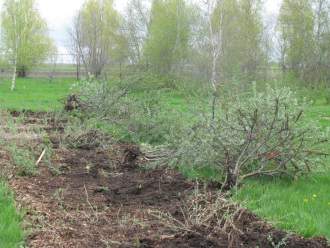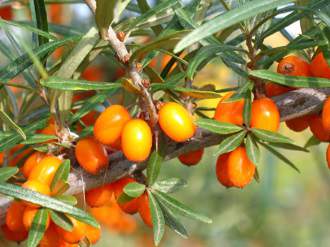Seaberry - Hippophae rhamnoides L
Seaberries have been removed from the CREC orchard.
Seaberries are grown in European and Asian countries such as China, Russia and Germany. They are one of the most vitamin-rich plants and are a well-known source of vitamin C, carotenoids, and vitamin E. Its fruit has the rare property of containing oils; its seed also has oil.
The plants are hardy to at least -40°F and can grow in poor, droughty soils and can tolerate salt spray along coastlines or roads. They are legumes and produce their own nitrogen. Seaberries spread aggressively from suckering root-shoots where there is bare soil, but are not as aggressive in sods. Pheasants and grouse are known to eat the fruit in winter, and migrating birds will eat fruit and insects attracted to the spoiling fruit in the fall.
In Asia, Germany and perhaps Russia, there is a seaberry industry that grows the fruit for juice and oil. Because the fruit does not have an abscission layer, it does not detach from the stem when it’s ripe. Harvest generally consists of cutting whole branches from the plant, freezing it, and then shaking the fruit off and cleaning it while it’s frozen. Mechanical harvesters are being developed and breeders are working to loosen the fruit from the branches.
Ag Canada’s Agroforestry Development Center has been breeding better seaberries. To date they have produced male plants with higher pollen counts and female plants that are more easily harvested with higher yields and less thorns. One of the scientists involved with the project indicates that it is a challenge to temper the excitement of growers and the public as the breeding work is too slow for an impatient industry.
Carrington planted six varieties of seaberries in 2007. Their growth was excellent and they produced great quantities of berries. There berries were, however, the most sour thing we have ever tasted! They had not one hint of sweetness and were very hard to pick. The sharp, thin thorns are hidden within the leaves and really make hand harvesting impossible, at least with any speed.
Seaberry plants sucker freely from their roots with most of this activity occurring within the mulched area of the row. Suckers did arise in the grass within one foot of the mulch, but had not spread further in the five years they grew. Of concern were several seedlings found growing 40-50 feet away from the planting. These plants grew from under a dogwood shrub surrounded by sod. Seedlings were also found growing at the Absaraka horticulture farm from plantings there. In winter 2010-11, I read a report in the Mar. 24, 2005 issue of the Botanical Electronic News www.ou.edu/cas/botany-micro/ben/ben345.html that relayed news of invasiveness of sea buckthorn in Alberta, Canada. These events led to their removal. However, at the summer 2012 NAFEX meeting, Canadian researchers reported that seaberry, in their experience, seemed to be only locally invasive (it just grows out from where it was planted).

Varieties previously planted-
German: ‘Askola’, ‘Hergo’
Buryatian: ‘Amber Dawn’, ‘Baikal’
Siberian: ‘Orange Delight’, ‘Siberian Splendor’



